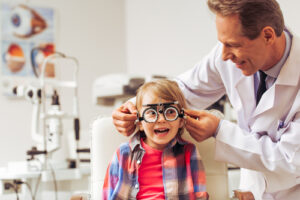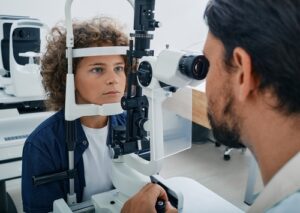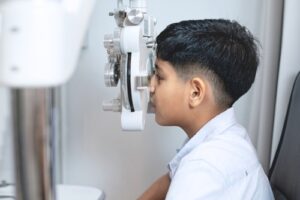As a parent, you want to ensure your child’s overall well-being, and their vision health is an essential part of that. Eye exams play a crucial role in identifying potential issues early on, allowing for timely intervention and proper care.
You may wonder when or how often you need to bring your children in to have their eyes checked by a professional. Keep reading to learn about the recommended timeline for children’s eye exams!

At What Age Should I Start Bringing My Child in for Eye Exams?
The best time to start scheduling eye exams for your child can vary depending on different factors, such as their unique circumstances and age-based guidelines. Although there are some general guidelines, it’s best to talk to a healthcare professional who can provide personalized recommendations based on your child’s specific needs.
Early Eye Exams
It’s important to note that vision problems can affect children of all ages. The American Optometric Association (AOA) recommends that infants receive their first comprehensive eye exam between six and twelve months of age.
This initial exam helps identify potential eye conditions or abnormalities that may interfere with their visual development.
Preschool Years
Between the ages of three and five, children should undergo another comprehensive eye exam. This examination assesses their visual acuity, eye movement skills, and overall eye health.
It is especially important before they begin school, as undiagnosed vision problems can hinder their learning abilities.
School-Aged Children
Once children enter school, it is recommended to have their vision tested every one to two years unless otherwise recommended by an eye care professional. Regular eye exams during this stage help monitor any changes in their vision and detect potential issues that may impact their academic performance or daily activities.
High-Risk Factors
Children with specific risk factors may require more frequent eye exams or earlier intervention. These risk factors include a family history of eye conditions, such as amblyopia or strabismus, premature birth, developmental delays, or certain medical conditions.
In such cases, consult with an eye care specialist to determine the appropriate examination schedule.
What Are Signs of Possible Vision Problems in Children?
As a parent, it’s crucial to keep an eye out for signs that may indicate vision problems in your child. Look for common indicators like frequent eye rubbing or complaints of headaches or eye strain.

Excessive blinking can also be a subtle clue that their eyes are struggling to focus or adjust properly. Squinting is another common behavior exhibited by children with vision issues.
It may indicate that they are trying to compensate for blurry vision or to improve their ability to see clearly. Difficulty focusing on objects or people, especially when it comes to reading or following along in class, could also be a sign of underlying vision concerns.
Poor eye-hand coordination is another red flag to watch out for. If your child has trouble catching or throwing objects accurately, struggles with handwriting or drawing tasks, or seems to lack precision in their motor skills, it might be worth investigating their visual capabilities.
Furthermore, be attentive to any complaints of headaches or eye strain from your child. These discomforts can stem from visual strain due to refractive errors or other eye-related issues that may require attention.
If you notice any of these indicators or have concerns about your child’s vision, it’s crucial to schedule an eye exam promptly. Early detection and intervention can play a pivotal role in helping your child overcome any potential obstacles related to their vision, empowering them to thrive academically, socially, and in their day-to-day activities.
Taking the initiative to proactively schedule regular eye exams for your child at the recommended ages is key to safeguarding their visual health and overall well-being. By prioritizing their eye health, you’re providing them with the best chances to thrive and excel in life.
Will My Child’s Eyes Be Dilated During the Examination?
During your child’s eye examination, whether their eyes will be dilated or not depends on the specific situation and the professional judgment of their eye doctor. Dilation is sometimes necessary to get a comprehensive view of the internal structures of the eyes, especially for older children or if there are specific concerns.
However, in some cases, there may be alternative methods available that allow for a thorough examination without dilation. Your child’s eye care professional at Blaine Eye Clinic will discuss the exam, including dilation, with you and address any questions or concerns you may have.
Are There Any Preparations or Precautions I Need to Take Before My Child’s Eye Exam?
Before your child’s eye exam, there are a few preparations and precautions you can take to ensure a smooth and productive appointment. First, it’s helpful to gather any relevant medical and vision history, including information about previous eye conditions or treatments.

Additionally, if your child wears glasses or contact lenses, make sure they bring them to the appointment. It’s also advisable to have a list of any medications or allergies your child may have.
Finally, if your child is anxious about the exam, reassuring them and explaining the process in a positive manner can help alleviate their concerns and make the experience more comfortable for them.
Is it time for your child to have an eye exam? Schedule an appointment at Blaine Eye Clinic in Blaine, MN, today!






